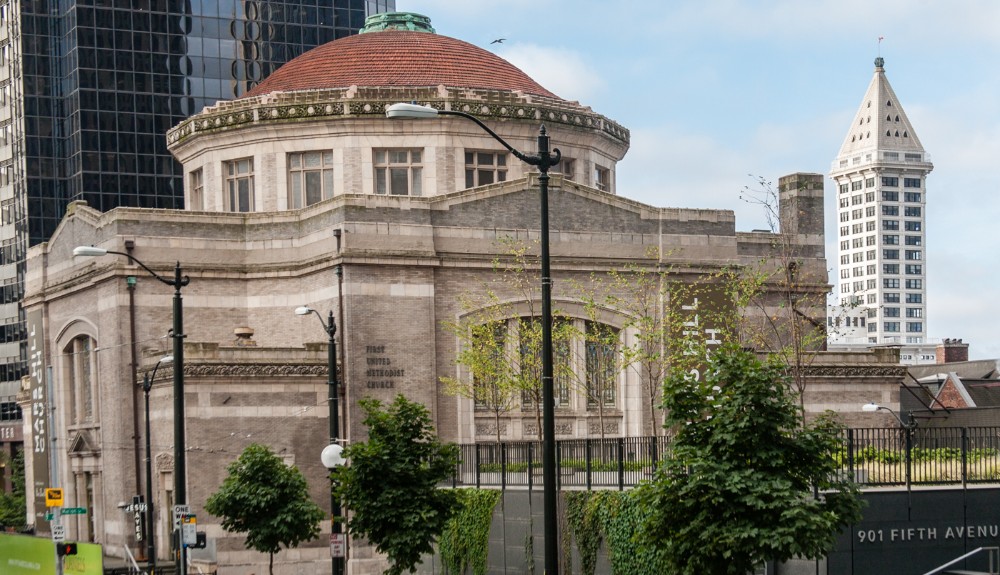Seattle, like many large cities, grew upward and outward, leaving handsome churches and synagogues behind. In some instances, these historic edifices have been boarded up or demolished. Occasionally they have struggled forward with shrinking congratulations. Now and then their raiment changes and we see these former houses of worship surface as discos, restaurants, immigrant halls, arts centers, and residences.
Temple de Hirsch Sinai, not exactly downtown, but close by at Fifteenth Avenue and Pike Street, re-built, utilizing some of its new space for a range of neighborhood and civic meetings. The Reform Jewish congregation hangs on, despite a one-time steady suburban exodus of membership, and the old sanctuary has been demolished for a Holocaust Garden.
Different examples: Seattle’s Plymouth Congregational Church and First Presbyterian Church, almost facing one another across central city and noisy Interstate 5 freeway, have adopted in other ways. Plymouth and First Presbyterian became activist and socially involved, attempting to deliver rollicking sermons in the tradition of Presbyterian’s famous former pastor, Mark A. Matthews. Recently, First Presbyterian voted to discontinue worship services, and faces likely redevelopment.
Another example of adaptability and survival among chaos and construction is Seattle’s First Methodist Church at Fifth Avenue and Marion Street. The church was founded by pioneers Arthur A. Denny, with help from John N. Nagle and Catherine Blaine. Originally known as “The White Church,” it began life in 1853 at Second Avenue and Columbia Street. After ten years of struggle and uninspiring sermons by David E. Blaine, the church listed six lonely members. Twenty years later it boasted a congregation of 90. In 1887 it moved to its present location and in 1909 built a remarkable ornate domed edifice.
Among the reasons for its move “uphill” was “to get out of the congested section of Seattle.” The building, now closed and its congregation relocated to north downtown, long enjoyed a reputation for its choirs and church music. First Methodist was frequently used for musical events and lectures. With enviable acoustics and a clear view from every seat, it became a noted cultural center among Seattle’s downtown vitality. Even so, it was not able to attract an active congregation as most members lived far from the Fifth Avenue and Marion Street corner, and the building was sold in 2007, facilitating a move to a smaller new building in Lower Queen Anne.
Big cities need the contrast and diversity of buildings with varying scale and design. Religious temples can offer such diversity and architectural appeal. However, many of the dwindling downtown congregations sit on valuable real estate, which are prime targets for sale and redevelopment. We need steeples along with skyscrapers.

As one who purchased the Fourth Church of Christ, Scientist, turning it into Town Hall Seattle on First Hill, I should add from my experience that developers are understandably gun shy about all the hoops one must go through to get a congregation (usually split) to agree to a sale, and those years of delay add a lot to a developer’s costs. Most churches have a sanctuary, a parking lot, and a support building, so there is often room for a new apartment tower, a renovated sanctuary, and support facilities in the apartment tower. Easier said than negotiated, alas.